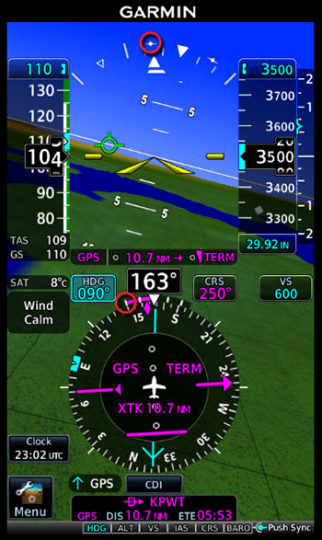Subscriber question:
"I’m transitioning to a glass panel airplane and the turn coordinator is now this little worm-like thing above the HSI. It’s so hard to simply set and hold a standard-rate turn. What am I doing wrong?" — Cedric P.
Bruce:
 “The problem may be where you’re focusing as you try to fly a standard-rate turn. The technique for establishing and flying a standard-rate turn is the same, whether you fly with a glass panel or conventional instruments, although electronic displays are now making the challenge easier.
“The problem may be where you’re focusing as you try to fly a standard-rate turn. The technique for establishing and flying a standard-rate turn is the same, whether you fly with a glass panel or conventional instruments, although electronic displays are now making the challenge easier.
I’ve watched many new (and some experienced) IFR pilots struggle with the control-performance method of basic instrument flying, which is the key to flying precisely when you’re on the gauges.
To establish and then maintain a constant-rate turn, start with the attitude indicator and reference it as you roll to the target bank angle that should result in a standard-rate turn based on your current airspeed.
Then cross-check your rate-of-turn indicator. That could be a mechanical turn-and-bank needle or turn coordinator, or it could be a magenta arc just above the HSI on a G1000 or similar PFD.
If the indicator shows that you’re turning too slowly or too rapidly, return to the attitude indicator. Focus on it to steepen or shallow the bank, and then recheck the turn coordinator. Repeat this process until you complete the turn.
If you use a turn coordinator or other turn-rate indicator to try to control the bank angle, your turn will be erratic, because the turn indicator is a performance instrument. It shows only if you’re achieving the desired result.
Remember that standard-rate turns require turning three degrees per second. Today, most primary flight displays show your rate of turn using tick marks above the digital HSI. When you turn, a magenta-colored band shows what your heading will be in six seconds at the current rate of turn. The arc grows or shrinks as you vary the bank angle and rate of turn. The tick marks indicate half-standard and standard rates of turn.
So how much should you bank to establish a standard rate turn? The angle required varies with true airspeed according to a complex relationship. Because solving trigonometric equations isn’t something most of us can do while flying, you can use a rule of thumb—15 percent of the true airspeed is a good target for the bank angle. In other words, divide true airspeed by 10 and add half again that amount. For example, at 100 knots, that’s 10 plus five, or 15 degrees of bank. At 120 knots, the same arithmetic suggests 18 degrees of bank, just shy of the 20-degree bank indicator on a typical AI.
The latest electronic flight displays, like the Garmin G5, G3x, and G500 Txi do the math for you. They display markers on the bank index of the attitude indicator to show the bank angle required for a standard-rate turn at the current true airspeed. To establish and maintain a standard-rate turn using one of these displays, smoothly roll into a bank that aligns with the mark, and then adjust the bank as airspeed changes.
You’ll hold a perfect standard-rate turn—and you’ll be using good control-performance technique by using the attitude indicator to set and maintain the target bank angle.”
Do you think a PFD makes it easier to fly on instruments?

